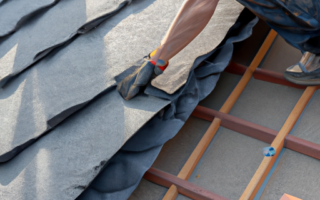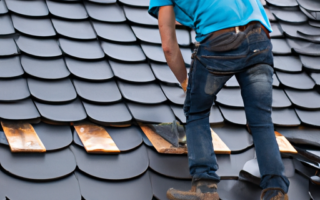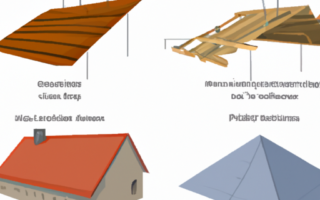Traditional Roofing Systems: A Timeless Approach to Roof Construction
Traditional Roofing Systems: A Timeless Approach to Roof Construction
When it comes to constructing roofs, traditional roofing systems have stood the test of time. These tried and tested techniques have been used for centuries and continue to be popular choices for homeowners and builders around the world. Traditional roofing systems offer a range of benefits, from durability and longevity to aesthetic appeal.
One of the most common traditional roofing systems is the pitched roof. This type of roof is characterized by its sloping design, which allows for effective water drainage and prevents water from pooling on the roof. Pitched roofs can be seen on many historic buildings, including churches, cottages, and manor houses.
Made from materials such as slate, clay tiles, and thatch, pitched roofs are known for their exceptional durability. These materials have proven to withstand harsh weather conditions, making them an excellent choice for regions with heavy rain, snow, or wind. Additionally, pitched roofs have a long lifespan, often lasting for several decades with proper maintenance.
Another traditional roofing system that has stood the test of time is the flat roof. Flat roofs are commonly found on commercial buildings, but they are also used on residential properties. This type of roof provides a clean and modern look and can be an excellent choice for contemporary or minimalist architectural designs.
Traditionally, flat roofs were constructed using materials such as tar and gravel, which provided a waterproof surface. However, modern flat roofing systems now utilize more advanced materials, such as rubber or thermoplastic membranes, which offer improved durability and flexibility.
One of the key benefits of traditional roofing systems is their aesthetic appeal. Whether it’s the charm of a thatched roof or the classic elegance of a slate roof, traditional roofing materials can enhance the overall look of a property. These roofs often blend seamlessly with the surrounding environment and architecture, further contributing to the visual appeal of a building.
While modern roofing systems offer a range of innovative features and materials, traditional roofing systems continue to be a popular choice for homeowners who appreciate their timeless appeal. Whether you’re looking to restore a historic property or create a classic look for your home, traditional roofing systems can provide durability, longevity, and aesthetic charm that will last for generations.
Modern Roofing Techniques: Innovations in Roofing Materials and Design
When it comes to modern roofing techniques, there have been significant innovations in both roofing materials and design. These advancements aim to improve the durability, energy efficiency, and aesthetic appeal of roofs.
One of the most notable innovations in modern roofing materials is the development of solar shingles or photovoltaic (PV) shingles. Unlike traditional solar panels, which are large and bulky, solar shingles are designed to blend seamlessly with the rest of the roof. They are made of thin film solar cells and can generate electricity while still providing protection from the elements. This is a great option for homeowners who want to harness solar energy without the need for a separate solar panel installation.
Another advancement in roofing materials is the development of cool roofs. These roofs are designed to reflect more sunlight and absorb less heat compared to traditional roofs, making them more energy-efficient. Cool roofs are usually made with reflective materials or coatings that help reduce the temperature of the roof surface and, in turn, the amount of heat transferred into the building. By reducing the need for excessive air conditioning, cool roofs can help lower energy costs and reduce carbon emissions.
In terms of design, modern roofing techniques also focus on improving ventilation systems. Proper ventilation is crucial to maintaining a healthy roof and preventing issues such as moisture buildup or ice dams. Innovations in roof design include the use of ridge vents, which allow hot air to escape from the attic, and soffit vents, which bring in cooler air from the outside. These ventilation systems help regulate temperature and reduce the risk of damage caused by moisture buildup.
Additionally, modern roofing techniques aim to enhance the overall durability and longevity of roofs. Synthetic roofing materials, such as synthetic slate or rubber roofing, offer improved resistance to weathering, UV rays, and impact damage compared to traditional materials. This means that homeowners can enjoy a longer lifespan for their roofs and potentially save on maintenance and repair costs in the long run.
In conclusion, modern roofing techniques have brought about significant innovations in both materials and design. From solar shingles to cool roofs and improved ventilation systems, these advancements aim to improve energy efficiency, durability, and aesthetic appeal. By embracing these modern techniques, homeowners can reap the benefits of a more sustainable and long-lasting roof.
Exploring Sustainable Roofing Systems: Environmentally Friendly Choices
Exploring Sustainable Roofing Systems: Environmentally Friendly Choices
When it comes to choosing a roofing system, sustainability and environmental impact are becoming increasingly important factors to consider. With the growing awareness of climate change and resource depletion, many homeowners and businesses are looking for ways to reduce their carbon footprint and contribute to a more sustainable future. In response to this demand, roofing industry has developed a range of environmentally friendly choices that go beyond traditional options.
One of the most popular sustainable roofing systems is the green roof. Green roofs are covered with vegetation, which helps to reduce heat absorption and provides natural insulation. These roofs also absorb rainwater, preventing excess water from entering storm drains and reducing the risk of flooding. Additionally, the vegetation on green roofs helps to filter air pollutants and improve air quality. Green roofs not only benefit the building occupants by providing a natural and visually appealing environment, but they also contribute to the overall health of the planet.
Another sustainable roofing option is solar roofing. Solar panels are integrated into the roof, allowing the building to generate its own electricity from sunlight. This reduces reliance on non-renewable energy sources and helps to offset the building’s energy consumption. In addition, excess energy produced by the solar panels can be fed back into the grid, further contributing to the local community’s energy needs. Solar roofing is not only an environmentally friendly choice, but it can also save the homeowner or business owner on energy costs in the long run.
For those looking for a more traditional roofing system, there are eco-friendly alternatives available as well. Recycled shingles, made from materials such as rubber or plastic, offer a sustainable option for roofing. These shingles are durable and long-lasting, reducing the need for frequent replacements. Furthermore, using recycled materials helps to conserve natural resources and reduce waste production.
In conclusion, exploring sustainable roofing systems is essential for those who are committed to reducing their environmental impact. Green roofs, solar roofing, and recycled shingles are just a few examples of the environmentally friendly choices available in the market today. By choosing a sustainable roofing system, homeowners and businesses can contribute to a greener future while also enjoying the benefits of energy efficiency and cost savings.
Choosing the Right Roofing System: Factors to Consider for Durability and Aesthetics
When it comes to choosing the right roofing system for your home or building, there are several factors to consider to ensure both durability and aesthetics. The roofing system you select will not only protect your property from the elements but also contribute to its overall appearance. With a wide range of options available, it’s important to understand these factors before making a decision.
Firstly, consider the climate in which your property is located. Different roofing systems are designed to withstand specific weather conditions. For instance, in areas prone to heavy rainfall or snowfall, a pitched roof with sloping angles can help prevent water or snow buildup. On the other hand, flat roofs are more suitable for regions with minimal precipitation.
Another important factor to consider is the lifespan of the roofing system. Traditional roofing materials like asphalt shingles have an average lifespan of 20 to 30 years, while metal roofs can last for over 50 years. Investing in a long-lasting roofing system can save you money in the long run, as you’ll avoid frequent repairs or replacements.
Additionally, the aesthetic appeal of the roofing system should not be overlooked. The roof is a prominent feature of any structure and can significantly impact its overall design. Traditional roofing materials such as clay or slate tiles can add a touch of elegance to your property. On the other hand, modern roofing systems like solar roofs or green roofs not only provide energy efficiency but also contribute to environmental sustainability.
Consider the architectural style of your property and choose a roofing system that complements it. For example, if you have a contemporary-style building, a flat roof or a metal roof with a sleek design can enhance its modern aesthetics. On the other hand, a traditional-style property may benefit from a roof with classic materials and ornate details.
Lastly, budget is an important consideration. Different roofing systems have varying costs, and it’s essential to determine how much you’re willing to invest. While traditional options like asphalt shingles tend to be more budget-friendly, alternative options like metal or tile roofs may require a higher initial investment but offer long-term cost savings.
Choosing the right roofing system involves considering the climate, lifespan, aesthetics, architectural style, and budget. By carefully evaluating these factors, you can ensure that your selected roofing system not only provides durability and protection but also enhances the overall appeal and value of your property.



